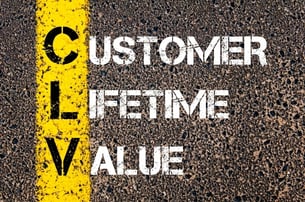 The secret to building value in a business is consistently producing new customers while expanding the revenue produced by each customer over time. In addition to contributing more revenue, the new products/services also tend to bind the customer more closely to the business which, in turn, tends to produce a longer customer relationship. The revenue and expected life of the average customer combine to produce a measure called Customer Lifetime Value (CLV). Growing the Customer Lifetime Value of a business is intuitively obvious as an effective strategy for building the value of a business. It starts with some pretty simple steps.
The secret to building value in a business is consistently producing new customers while expanding the revenue produced by each customer over time. In addition to contributing more revenue, the new products/services also tend to bind the customer more closely to the business which, in turn, tends to produce a longer customer relationship. The revenue and expected life of the average customer combine to produce a measure called Customer Lifetime Value (CLV). Growing the Customer Lifetime Value of a business is intuitively obvious as an effective strategy for building the value of a business. It starts with some pretty simple steps.1) Engage in value stream mapping, a concept of lean production planning that calls for mapping the production process of each product or service from the perspective of the customer. It is used to eliminate muda (activities that are not value added for the customer). It is also effective in highlighting areas where more value can be applied, thus planting the seed of greater Customer Lifetime Value. This can be done with Excel but some very nice tools exist for better mapping. SmartDraw sells very good drawing software and offers a value stream mapping tool set.
2. Produce residual Income. Look for opportunities to provide services that engage the customer repeatedly. Residual income services enhance Customer Lifetime Value by contributing new revenue opportunities and by creating a bind that makes separation more difficult for the customer. As we wrote in Create Happier Customers with Lean Practices, a product tracking system can accomplish this for both manufacturers and contractors. Ideas for residual income services can often result from the value stream mapping process.
3. Provide solutions. Don't sell products, sell solutions. Businesses that see their roles as centered in the value of their products will experience worsening margin pressures. However, businesses that partner with their customers to solve problems win their loyalty and therefore their longevity. This is how we approach our work with our customers at Idencia... by providing infrastructure asset tracking solutions to help them be more productive and add more value to their customers. This is also consistent with lean manufacturing principles, which call for constant review of how more customer value can be created more efficiently.
Experienced practioners are quick to point out that lean practices require participation up and down the value chain since all companies involved are parties to an interdependent network. It is our vision that manufacturers, contractors and project owners will embrace lean practices for their own benefit as well as to produce the productivity gains needed to meet the massive global infrastructure investment challenge ahead of us. The result will be lean infrastructure, a physical network providing the greatest possible value at the most efficient cost.
If you would like to learn more about how Idencia can help your company grow the lifetime value of its customers, we invite you to review our report on 17 Ways Lean Manufacturing Can Improve Profits Win Bids.
About Idencia
Our purpose at Idencia is to offer precast RFID tracking solutions that improve productivity throughout the value chain. Our subscription offering applies to products from the time of manufacture through end-of-life. As a cloud-hosted product tracking system that is seamless between manufacturers, contractors and asset managers, Idencia adds information value to all, eliminates redundancy and saves time. If you would like to learn more, click below.
Tags:
Market Insights
May 13, 2015 7:15:00 PM




Comments